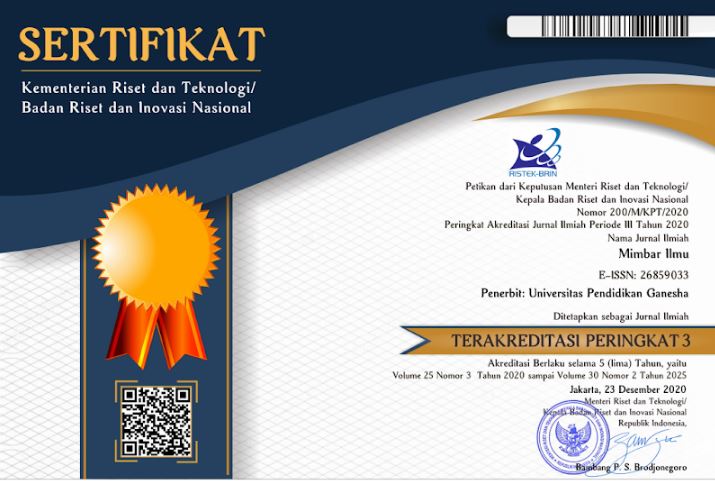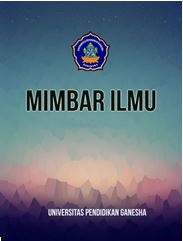Formative and Summative Assessment Using Technology: A Critical Review
DOI:
https://doi.org/10.23887/mi.v29i1.72042Kata Kunci:
Formative Assessment, Summative Assessment, Technology and FeedbackAbstrak
The use of technology in the classroom has revolutionized the teaching process by giving educators more freedom and opportunities to differentiate instruction. The purpose of this research is to critically assess a variety of technological approaches that were particularly chosen for their compatibility with and ability to improve on existing assessment for learning practices. The underlying viewpoints are that (a) summative and formative evaluations are both important learning opportunities, and (b) utilizing technology can improve learning throughout evaluation and feedback processes. The research method uses Systematic Literature Review (SLR). A literature search was conducted through academic databases, such as PubMed, ERIC, and Google Scholar. The benefits and downsides of employing technology are evaluated using research from a research study through literature. It is said that the usage of various forms of technology can aid in the facilitation of efficient assessment for learning and feedback in higher education by adopting a flexible strategy and taking tiny incremental steps. In a supportive learning environment, where a staff-student approach can be particularly helpful, trust between students and staff can help innovative methods succeed.
Referensi
Balakrishnan Nair, B. (2022). Endorsing gamification pedagogy as a helpful strategy to offset the COVID-19 induced disruptions in tourism education. Journal of Hospitality, Leisure, Sport and Tourism Education, 30(July 2021), 100362.1-9. https://doi.org/10.1016/j.jhlste.2021.100362.
Basyoni, A., Bee, M., S., H., Seng, G., & H. (2020). The effectiveness of using students’ created digital storytelling in enhancing Saudi ninth graders’ critical listening skills. Journal of Education and Social Sciences, 16(1), 58–72. https://doi.org/https://www.jesoc.com/wp-content/uploads/2020/12/JESOC16-030.pdf.
Cahyono, B. Y., Mukminatien, N., & Amrina, R. (2016). Indonesian Students Writing Proficiency in Using Complex Sentence. International Journal on Studies in English Language and Literature (IJSELL), 4(9), 22–32. https://www.researchgate.net/profile/Bambang-Cahyono-3/publication/311707316.
Charlina, C., & Septyanti, E. (2019). Pemanfaatan media kahoots sebagai motivasi belajar mengikuti kuis wacana bahasa Indonesia. Geram (Gerakan Aktif Menulis, 7(2), 78–82. https://doi.org/10.25299/geram.2019.vol7(2).4036.
Dias, S. B., Hadjileontiadou, S. J., Diniz, J., & Hadjileontiadis, L. J. (2020). DeepLMS: a deep learning predictive model for supporting online learning in the Covid-19 era. Scientific Reports, 10(1), 19888. https://doi.org/10.1038/s41598-020-76740-9.
Dishon, G., & Gilead, T. (2020). Adaptability And Its Discontents : 21st- Century Skills And The Preparation For An Unpredictable Future. British Journal of Educational Studies, 00(00), 1–21. https://doi.org/10.1080/00071005.2020.1829545.
Elmahdi, I., Al-Hattami, A., & Fawzi, H. (2018). Using Technology for Formative Assessment to Improve Students’ Learning. Turkish Online Journal of Educational Technology-TOJET, 17(2), 182–188. https://eric.ed.gov/?id=EJ1176157.
Elshami, W., Taha, M. H., Abuzaid, M., Saravanan, C., Al Kawas, S., & Abdalla, M. E. (2021). Satisfaction with online learning in the new normal: perspective of students and faculty at medical and health sciences colleges. Medical Education Online, 26(1). https://doi.org/10.1080/10872981.2021.1920090.
Faqih, K. M. S., & Jaradat, M.-I. R. M. (2015). Assessing the moderating effect of gender differences and individualism-collectivism at individual-level on the adoption of mobile commerce technology: TAM3 perspective. Journal of Retailing and Consumer Services, 22, 37–52. https://doi.org/10.1016/j.jretconser.2014.09.006.
Fatimah, A. S., & Santiana, S. (2017). Teaching in 21St Century: Students-Teachers’ Perceptions of Technology Use in the Classroom. Script Journal: Journal of Linguistic and English Teaching, 2(2), 125. https://doi.org/10.24903/sj.v2i2.132.
Fearnley, M. R., & Amora, J. T. (2020). Learning Management System Adoption in Higher Education Using the Extended Technology Acceptance Model. IAFOR Journal of Education, 8(2), 89–106. https://doi.org/10.22492/ije.8.2.05.
Frydenberg, M. E., & Andone, D. (2011). Learning for 21st Century Skills. IEEE’s International Conference on Information Society, 314–318. https://doi.org/10.1109/i-Society18435.2011.5978460.
Ghavifekr, S., Razak, A., Ghani, M., Ran, N., Meixi, Y., & Tengyue, Z. (2014). ICT Integration in Education: Incorporation for Teaching & Learning Improvement. Malaysian Online Journal of Educational Technology, 2(2), 24–45. https://eric.ed.gov/?id=EJ1086419.
Ghavifekr, S., & Rosdy, W. A. W. (2015). Teaching and learning with technology: Effectiveness of ICT integration in schools. International Journal of Research in Education and Science, 1(2), 175–191. https://doi.org/10.21890/ijres.23596.
Gikandi, J. W., & Morrow, D. (2016). Designing and implementing peer formative feedback within online learning environments. Technology, Pedagogy and Education, 25(2), 153–170. https://doi.org/10.1080/1475939X.2015.1058853.
Grimes, D., & Warschauer, M. (2010). Utility in a fallible tool: A multi-site case study of automated writing evaluation. Journal of Technology, Learning, and Assessment, 8(6). https://ejournals.bc.edu/index.php/jtla/article/view/1625.
Gubbels, J., Swart, N. M., & Groen, M. A. (2020). Everything in moderation: ICT and reading performance of Dutch 15-year-olds. Large-Scale Assessments in Education, 8(1), 1–17. https://doi.org/10.1186/s40536-020-0079-0.
Hasan, H. F., Nat, M., & Vanduhe, V. Z. (2019). Gamified Collaborative Environment in Moodle. IEEE Access, 7, 89833–89844. https://doi.org/10.1109/ACCESS.2019.2926622.
Hidayat, I., Supriani, A., Setiawan, A., & Lubis, A. (2023). Implemantasi aplikasi kahoot sebagai media pembelajaran interaktif dengan siswa SMP negeri 1 Kunto Darussalam. Journal on Education, 6(1), 6933–6942. https://doi.org/10.31004/joe.v6i1.3924.
Hwang, G. J., Chang, C. C., & Chien, S. Y. (2022). A motivational model‐based virtual reality approach to prompting learners’ sense of presence, learning achievements, and higher‐order thinking in professional safety training. British Journal of Educational Technology, 53(5). https://doi.org/10.1111/bjet.13196.
Ibrahim, R., Leng, N. S., Yusoff, R. C. M., Samy, G. N., Masrom, S., & Rizman, Z. I. (2018). E-learning acceptance based on technology acceptance model (TAM). Journal of Fundamental and Applied Sciences, 9(4S), 871. https://doi.org/10.4314/jfas.v9i4s.50.
Imam, I., Ayubi, A., & Bernard, M. (2018). Pengaruh Pembelajaran Berbasis Masalah Terhadap Kemampuan Pemecahan Masalah Matematis Siswa SMA. JPMI:Jurnal Pembelajaran Matematika Inovatif, 1(3), 355–360. https://doi.org/10.22460/jpmi.v1i3.355-360.
Ioannou, A., Vasiliou, C., & Zaphiris, P. (2016). Problem-Based Learning in Multimodal Learning Environments: Learners’ Technology Adoption Experiences. Journal of Educational Computing Research, 54(7), 1022–1040. https://doi.org/10.1177/0735633116636755.
Irving, K. E. (2006). The impact of technology on the 21st century. Teaching Science in the 21st Century, March 1981, 3–19. https://cmapsconverted.ihmc.us/rid=1JVHR9TKT-1VMCFZP-SHW/21st century.pdf.
Jahnke, I., & Liebscher, J. (2020). Three types of integrated course designs for using mobile technologies to support creativity in higher education. Computers and Education, 146(March 2020), 103782.1-28. https://doi.org/10.1016/j.compedu.2019.103782.
Keinänen, A. L., Lähdesmäki, R., Juntunen, J., Tuomikoski, A. M., Kääriäinen, M., & Mikkonen, K. (2023). Effectiveness of mentoring education on health care professionals´ mentoring competence: A systematic review. Nurse Education Today, 121(January), 1-10. https://doi.org/10.1016/j.nedt.2023.105709.
Kilis, S., & Yildirim, Z. (2019). Posting Patterns of Students’ Social Presence, Cognitive Presence, and Teaching Presence in Online Learning ONLINE LEARNING. Online Learning, 23(2), 179–195. https://avesis.metu.edu.tr/yayin/c602500e-43ee-41cb-8d82-1240bba9f249/posting-patterns-of-students-social-presence-cognitive-presence-and-teaching-presence-in-online-learning.
Lampropoulos, G., Siakas, K., & Anastasiadis, T. (2019). Internet of Things in the Context of Industry 4.0: An Overview. International Journal of Entrepreneurial Knowledge, 7(1), 4–19. https://doi.org/10.2478/ijek-2019-0001.
Li, L. (2021). Intelligent Evaluation of College Students’ Ideological and Political Education Effect Based on Big Data Technology. 2021 International Conference on Intelligent Transportation, Big Data and Smart City, ICITBS 2021, 418–421. https://doi.org/10.1109/ICITBS53129.2021.00109.
Liaw, S. S., & Huang, H. M. (2013). Perceived satisfaction, perceived usefulness and interactive learning environments as predictors to self-regulation in e-learning environments. Computers & Education, 60(1), 14–24. https://doi.org/10.1016/j.compedu.2012.07.015.
Lin, Q., Zhu, Y., Lu, H., Shi, K., & Niu, Z. (2021). Improving University Faculty Evaluations via multi-view Knowledge Graph. Future Generation Computer Systems, 117(4), 181–192. https://doi.org/10.1016/j.future.2020.11.021.
Maamuujav, U., Krishnan, J., & Collins, P. (2019). The utility of infographics in L2 writing classes: A practical strategy to scaffold writing development. TESOL Journal, September. https://doi.org/10.1002/tesj.484.
Machay, B., Ruiz, C., Contero, N., & Nogales, D. (2022). Assisted Pedagogy: Robot Alpha for Gross Motor Learning in Sublevel I. International Conference on Innovation and Research, 203–215. https://link.springer.com/chapter/10.1007/978-3-031-11438-0_17.
Malmquist, S. J., & Collins, W. F. (2016). Novel graduated engagement strategy tools for enhancing student success in a large diverse introductory physiology course. FASEB Journal. Conference: Experimental Biology, 30(8), 553. https://faseb.onlinelibrary.wiley.com/doi/abs/10.1096/fasebj.30.1_supplement.553.8.
Manfra, M. M. (2019). Action research and systematic, intentional change in teaching practice. Review of Research in Education, 43(1), 163–196. https://doi.org/10.3102 /0091732X18821132.
Miller, T. (2018). Developing numeracy skills using interactive technology in a play-based learning environment. International Journal of STEM Education, 5(1). https://doi.org/10.1186/s40594-018-0135-2.
Moradi, H., & Chen, H. (2019). Digital storytelling in language education. Behavioral Sciences, 9(12), 1–9. https://doi.org/10.3390/bs9120147.
Morrar, R., Arman, H., & Mousa, S. (2017). The fourth industrial revolution (Industry 4.0): A social innovation perspective. Technology Innovation Management Review, 7(11), 12–20. https://timreview.ca/sites/default/files/Issue_PDF/TIMReview_November2017.pdf#page=12.
Motlhaka, H. (2020). Blackboard collaborated-based instruction in an academic writing class: sociocultural perspectives of learning. Electronic Journal of E-Learning, 18(4), 337–346. https://doi.org/10.34190/EJEL.20.18.4.006.
Nair, V., Yunus, M., & Md. (2022). Using digital storytelling to improve pupils’ speaking skills in the age of COVID 19. Sustainability, 14, 1–19. https://doi.org/10.3390/su14159215.
Nursyahrina, H., Retami, L. H., Pratama, R., Salsabil, S. P., & Ihsan, M. T. (2021). the Use of Google Classroom in English Teaching and Learning Process At Senior High School Level. Jurnal Riset Dan Inovasi Pembelajaran, 1(2), 123–133. https://doi.org/10.51574/jrip.v1i2.41.
Riddell, J. (2015). Performance, Feedback, and Revision: Metacognitive Approaches to Undergraduate Essay Writing. Collected Essays on Learning and Teaching, 8, 79. https://doi.org/10.22329/celt.v8i0.4256.
Sanchez, J., Maiden, J., Barton, E., Walters, L., Quinn, D., Jones, N., Doyle, A. K., & Lim, D. (2023). Factors that sustain indigenous youth mentoring programs: a qualitative systematic review. BMC Public Health, 23(1), 1–15. https://doi.org/10.1186/s12889-023-15253-2.
Schunk, D. H., & DiBenedetto, M. K. (2020). Motivation and social cognitive theory. Contemporary Educational Psychology, 60, 101832. https://doi.org/10.4103/0019-5154.182410.
Sefriani, R., & Sepriana, R. (2022). Technology Acceptance Model : the use of E-Study Aplications in. Journal of Education Technology, 6(4), 704–710. https://doi.org/10.23887/jet.v6i4.45457.
Shakir, M. A. (2021). Assessment of Learning Achievement of Visually Impaired Children at Primary Level. Pakistan Journal of Educational Research and Evaluation, 9(2), 44–52. http://journals.pu.edu.pk/journals/index.php/PJERE/article/view/5311.
Su, J., Zhong, Y., & Ng, D. T. K. (2022). A meta-review of literature on educational approaches for teaching AI at the K-12 levels in the Asia-Pacific region. Computers and Education: Artificial Intelligence, 3(March), 100065.1-18. https://doi.org/10.1016/j.caeai.2022.100065.
Tise, J. C., Hernandez, P. R., & Wesley Schultz, P. (2023). Mentoring underrepresented students for success: Self-regulated learning strategies as a critical link between mentor support and educational attainment. Contemporary Educational Psychology, 75(October), 102233.1-14. https://doi.org/10.1016/j.cedpsych.2023.102233.
Torres-Gastelú, C. A., & Kiss, G. (2016). Perceptions of students towards ICT competencies at the University. Informatics in Education, 15(2), 319–338. https://doi.org/10.15388/infedu.2016.16.
Vartiainen, H., Pöllänen, S., & Liljeström, A. (2016). Designing Connected Learning: Emerging learning systems in a craft teacher education course. Design And, 21(2), 32–40. https://ojs.lboro.ac.uk/DATE/article/download/2115/2281.
Vrancken, J., De Gryse, L., & Spooren, A. I. F. (2021). Hospiavontuur: Development of a Serious Game to Help Young Children and Their Parents During the Preparation for an Admission at the Hospital for Elective Surgery. Behaviour & Information Technology, 40(2), 134–145. https://doi.org/10.1080/0144929X.2019.1673821.
Widiaswanti, E., Pratikto, P., Cahyani, C., & Tama, I. P. (2019). A Conceptual Framework for Essential Oils Marketing: A Systems Approach. International Journal on Food System Dynamics, 10(4), 386–395. https://doi.org/10.18461/IJFSD.V10I4.26.
Wu, X. ., He, Z. ., Li, M. ., Han, Z. ., & Huang, C. (2022). Identifying Learners’ Interaction Patterns in an Online Learning Community. Int. J. Environ. Res. Public Health, 19, 2245. https://doi.org/10.3390/ ijerph19042245.
Yazon, A. D., Ang-Manaig, K., Buama, C. A. C., & Tesoro, J. F. B. (2019). Digital literacy, digital competence and research productivity of educators. Universal Journal of Educational Research, 7(8), 1734–1743. https://doi.org/10.13189/ujer.2019.070812.
Zhao, C., Chen, M., Zhao, J., Wang, Q., & Shen, Y. (2019). 3D behavior recognition based on multi-modal deep space-time learning. Applied Sciences, 9(4), 716. https://doi.org/10.3390/app9040716.
Unduhan
Diterbitkan
Cara Mengutip
Terbitan
Bagian
Lisensi
Hak Cipta (c) 2023 Samuel Adebisi Onasanya , Adesoye Oladunni Ajamu

Artikel ini berlisensiCreative Commons Attribution-ShareAlike 4.0 International License.
This work is licensed under a Creative Commons Attribution-ShareAlike 4.0 International License.
Authors who publish with this journal agree to the following terms:
- Authors retain copyright and grant the journal right of first publication with the work simultaneously licensed under a Creative Commons Attribution License that allows others to share the work with an acknowledgment of the work's authorship and initial publication in this journal.
- Authors are able to enter into separate, additional contractual arrangements for the non-exclusive distribution of the journal's published version of the work (e.g., post it to an institutional repository or publish it in a book), with an acknowledgment of its initial publication in this journal.
- Authors are permitted and encouraged to post their work online (e.g., in institutional repositories or on their website) prior to and during the submission process, as it can lead to productive exchanges, as well as earlier and greater citation of published work.









